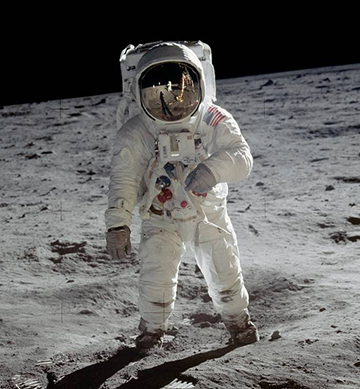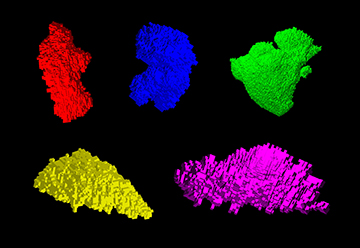![]()
[Image: Christophe Lehenaff/Getty Images]
For poets, painters and philosophers, few things are more evocative than moonlight. For the scientist, however, understanding the reflected radiance from the moon—or any other planetary body—amounts to a tantalizing inverse problem, involving the interplay of variables such as planetary composition, angle of illumination, surface geometry, and the size of the light-scattering particles on the lunar surface.
Figuring out how these many variables combine to produce the moon’s reflected spectra is important for mapping variations in composition and structure across the lunar surface. It’s also a key to extrapolating knowledge of the moon’s reflected light to light from other, unvisited bodies in the solar system and beyond. A U.S. research team—by combining an ultrasensitive measurement technique, X-ray nano computed tomography (XCT), with numerical modeling—has begun to unravel the complexities of a particularly tricky part of the problem: how the shape of lunar dust particles less than a micrometer in size affects the way they scatter light (IEEE Geosci. Remote Sens. Lett., doi: 10.1109/LGRS.2021.3073344).
An old optical problem
The optical characteristics of moondust have drawn scientific interest for many years. For example, when U.S. astronaut Eugene A. Cernan returned to Earth on 19 December 1972 at the end of the Apollo 17 mission—the last time humans have walked on the moon—one of the things he brought with him was sketches of strange linear “streamers” the crew had observed at sunrise in lunar orbit. The streamers are usually interpreted as resulting from sunlight scattering off of tiny lunar dust particles suspended in the moon’s extremely tenuous atmosphere, or exosphere.
A more quantitative view of these phenomena, and of the scattering of light off of the moon’s surface as well, requires a detailed understanding of the lunar regolith—the combination of rock and fine soil that has resulted as the planet’s surface has been pulverized by meteoroids over the past 4.6 billion years. For some time it was assumed, based on the suite of samples returned by the Apollo program, that the average particle size in the lunar soil was around 50 µm, with about 14% of the particles sizing up at less than 10 µm. Work in the late 2000s, however, using laser diffraction techniques, illuminated a substantial portion of lunar dust particles at diameters ranging from 100 to 1000 nm.
The shape of the thing
It is these fine particles—specifically, the fraction between 400 and 1000 nm—that intrigued the team behind the new work, which includes scientists at the U.S. National Institute of Standards and Technology (NIST), the University of Missouri–Kansas City, the U.S. Air Force Research Laboratory and the Space Science Institute, USA. Specifically, the team wanted to quantify the impact that the shape of these exotic particles, with a length scale comparable to optical wavelengths, has on their light-scattering characteristics. Earth materials provide little help, as the violent processes that have given rise to lunar dust are very different from the tamer ones that have built terrestrial soils.

Iconic shot, snapped by astronaut Neil Armstrong, of fellow astronaut Edwin “Buzz” Aldrin, surrounded by moondust, during the Apollo 11 mission. [Image: NASA]
To get some ground truth into their analysis, the researchers turned to the much-pawed-over lunar soil samples from the Apollo 11 mission, brought to Earth more than a half-century ago. They also took advantage of a relatively new technique, XCT, to study the fraction below one micron in size.
The technique involves stirring sample material into epoxy, spreading the resulting slurry into a thin layer and wrapping a bit of the layer around a cylindrical object (in this work, dressmaker’s pins were used). The cylinder is then inserted into an X-ray instrument and rotates, rotisserie style, for several hours while the XCT measurement is being made. The instrument—similar to macro-scale computed tomography (CT) scans in the medical clinic—uses the multiple X-ray images to produce computer-generated “slices” or cross-sections of the sub-micron particles, which can be built up into a 3D image.
Next, the team used 25 such images to create digital models of the 3D particle shapes, broken up into individual volume elements, or voxels. To work out the particles’ light-scattering properties from those digital models, the researchers relied on the so-called discrete dipole approximation (DDA), in which each voxel is assumed to represent an individual simple dipole that interacts both with the incident electromagnetic field and the other dipoles. This allows the creation of a polarization matrix for the particle that’s amenable to computational wrangling. That matrix, along with an open-source software library, allowed the team to solve for the particle’s optical-scattering characteristics—particularly the wavelength and amplitude of the scattered light.
The research team behind the new work collected images of individual lunar regolith particles between 400 and 1000 nm in size, and then descretized them into individual volume elements, or voxels, for computer modeling of their optical properties. [Image: E. Garboczi/NIST and A. Sharits/AFRL] [Enlarge image]
Important wavelength impact
The team’s analysis showed that the shape of the sub-micron lunar dust particles can have a big impact on the wavelength of light reflected from them. On average, the researchers found that the lunar regolith particles they modeled would have resonance wavelengths some 20% lower than spherical particles of the same volume. Interestingly, however, the peak amplitude at that resonance wavelength was relatively insensitive to the particle shape. And the lunar regolith particles apparently generate a slightly lower single scattering albedo (essentially, scattering efficiency relative to absorption efficiency) than spherical particles.
The authors write that the results “highlight the importance of accounting for 3-D shape variations in understanding the optical response of lunar regolith particles.” The team hopes to take the analysis further by studying a wider range of particles, including some harvested from the Apollo 14 mission (which sampled a different part of the moon from Apollo 11), and by extending the study to additional optical parameters.
In a press release accompanying the work, study coauthor Jay Goguen of the Space Science Institute said that the models developed by the team will “form the basis of future calculations that could model observations of the spectrum, brightness and polarization of the moon’s surface and how those observed quantities change during the moon’s phases.”

